VLSI Implementation of a Cost-Efficient Loeffler DCT Algorithm with Recursive CORDIC for DCT-Based Encoder
Abstract
1. Introduction
2. The Image Compression Algorithm
2.1. JPEG
2.2. DCT
2.3. 2-D DCT Using Row-Column 1-D DCT Architecture
2.4. CORDIC Algorithm
2.5. Loeffler DCT Algorithm with Recursive CORDIC
3. VLSI Architecture
4. Experimental Results of the Proposed Loeffler DCT Algorithm with Recursive CORDIC
5. Conclusions
Author Contributions
Funding
Acknowledgments
Conflicts of Interest
References
- Xu, K.; Qu, Y.; Yang, K. A tutorial on the internet of things: From a heterogeneous network integration perspective. IEEE Network 2016, 30, 102–108. [Google Scholar] [CrossRef]
- Movassaghi, S.; Abolhasan, M.; Lipman, J.; Smith, D.; Jamalipour, A. Wireless body area networks: A survey. IEEE Commun. Surv. Tutor. 2014, 16, 1658–1686. [Google Scholar] [CrossRef]
- Khan, I.; Belqasmi, F.; Glitho, R.; Crespi, N.; Morrow, M.; Polakos, P. Wireless sensor network virtualization: A survey. IEEE Commun. Surv. Tutor. 2016, 18, 553–576. [Google Scholar] [CrossRef]
- Misra, S.; Reisslein, M.; Xue, G. A survey of multimedia streaming in wireless sensor networks. IEEE Commun. Surv. Tutor. 2008, 10, 18–39. [Google Scholar] [CrossRef]
- Noel, A.B.; Abdaoui, A.; Elfouly, T.; Ahmed, M.H.; Badawy, A.; Shehata, M.S. Structural health monitoring using wireless sensor networks: A comprehensive survey. IEEE Commun. Surv. Tutor. 2017, 19, 1403–1423. [Google Scholar] [CrossRef]
- Goldstein, P. Ericsson Backs Away from Expectation of 50B Connected Devices by 2020, Now Sees 26B. Available online: https://www.fiercewireless.com/wireless/ericsson-backs-away-from-expectation-50b-connected-devices-by-2020-now-sees-26b (accessed on 3 June 2015).
- Kobo, H.I.; Abu-Mahfouz, A.M.; Hancke, G.P. A survey on software-defined wireless sensor networks: Challenges and design requirements. IEEE Access 2017, 5, 1872–1899. [Google Scholar] [CrossRef]
- Chen, C.-A.; Wu, C.; Abu, P.A.R.; Chen, S.-L. VLSI implementation of an efficient lossless EEG compression design for wireless body area network. Appl. Sci. 2018, 8, 1474. [Google Scholar] [CrossRef]
- Chiang, W.-Y.; Ku, C.-H.; Chen, C.-A.; Wang, L.-Y.; Abu, P.A.R.; Rao, P.-Z.; Liu, C.-K.; Liao, C.-H.; Chen, S.-L. A power-efficient multiband planar USB dongle antenna for wireless sensor networks. Sensors 2019, 19, 2568. [Google Scholar] [CrossRef] [PubMed]
- Chen, S.-L.; Chi, T.-K.; Tuan, M.-C.; Chen, C.-A.; Wang, L.-H.; Chiang, W.-Y.; Lin, M.-Y.; Abu, P.A.R. A novel low-power synchronous preamble data line chip design for oscillator control interface. Electronics 2020, 9, 1–16. [Google Scholar]
- Zhou, L.; Chao, H.-C. Multimedia traffic security architecture for the internet of things. IEEE Network 2011, 25, 35–40. [Google Scholar] [CrossRef]
- Mekonnen, T.; Porambage, P.; Harjula, E.; Ylianttila, M. Energy consumption analysis of high quality multi-tier wireless multimedia sensor network. IEEE Access 2017, 5, 15848–15858. [Google Scholar] [CrossRef]
- Aurangzeb, K.; Alhussein, M.; O’Nils, M. Analysis of binary image coding methods for outdoor applications of wireless vision sensor networks. IEEE Access 2018, 6, 16932–16941. [Google Scholar] [CrossRef]
- Chen, S.-L.; Liu, T.-Y.; Shen, C.-W.; Tuan, M.-C. VLSI implementation of a cost-efficient near- lossless CFA image compressor for wireless capsule endoscopy. IEEE Access 2016, 4, 10235–10245. [Google Scholar] [CrossRef]
- Kougianos, E.; Mohanty, S.P.; Coelho, G.; Albalawi, U.; Sundaravadivel, P. Design of a high-performance system for secure image communication in the internet of things. IEEE Access 2016, 4, 1222–1242. [Google Scholar] [CrossRef]
- Alletto, S.; Cucchiara, R.; Fiore, G.D.; Mainetti, L.; Mighali, V.; Patrono, L.; Serra, G. An indoor location-aware system for an IoT-based smart museum. IEEE Internet Things J. 2016, 3, 244–253. [Google Scholar] [CrossRef]
- Schwager, M.; Julian, B.J.; Angermann, M.; Rus, D. Eyes in the sky: Decentralized control for the deployment of robotic camera networks. Proc. IEEE 2011, 99, 1541–1561. [Google Scholar] [CrossRef]
- Pennebaker, W.; Mitchell, J. JPEG still Image Data Compression Standard; Van Nostrand Reinhold: New York, NY, USA, 1992. [Google Scholar]
- Andrea, P.; Scavongelli, C.; Orcioni, S.; Conti, M. Performance analysis of JPEG 2000 over 802.15.4 wireless image sensor network. In Proceedings of the 8th Workshop on Intelligent Solutions in Embedded Systems, Heraklion, Greece, 8–9 July 2010; pp. 55–60. [Google Scholar]
- Mohanty, S.P.; Kougianos, E.; Guturu, P. SBPG: Secure better portable graphics for trustworthy media communications in the IoT. IEEE Access 2018, 6, 5939–5953. [Google Scholar] [CrossRef]
- Cohen, A.; Nissim, N.; Elovici, Y. MalJPEG: Machine learning based solution for the detection of malicious JPEG images. IEEE Access 2020, 30, 19997–20011. [Google Scholar] [CrossRef]
- Harish, A.N.; Nissim, N.; Verma, V.; Khanna, N. Double JPEG compression detection for distinguishable blocks in images compressed with same quantization matrix. In Proceedings of the 2020 IEEE 30th International Workshop on Machine Learning for Signal Processing (MLSP), Espoo, Finland, 21–24 September 2020. [Google Scholar]
- Zeng, J.; Tan, S.; Li, B.; Huang, J. Large-scale JPEG image steganalysis using hybrid deep-learning framework. IEEE Trans. Inf. Forensics Secur. 2018, 13, 1200–1214. [Google Scholar] [CrossRef]
- Coelho, D.F.G.; Cintra, R.J.; Kulasekera, S.; Madanayake, A.; Dimitrov, V.S. Error-free computation of 8-point discrete cosine transform based on the Loeffler factorisation and algebraic integers. IET Signal Process. 2016, 10, 633–640. [Google Scholar] [CrossRef]
- Pastuszak, G. Hardware architectures for the H.265/HEVC discrete cosine transform. IET Image Process. 2015, 9, 468–477. [Google Scholar] [CrossRef]
- Kalali, E.; Mert, A.C.; Hamzaoglu, I. A computation and energy reduction technique for HEVC discrete cosine transform. IEEE Trans. Consum. Electron. 2016, 62, 166–174. [Google Scholar] [CrossRef]
- Masera, M.; Martina, M.; Masera, G. Adaptive approximated DCT architectures for HEVC. IEEE Trans. Circuits Syst. Video Technol. 2017, 27, 2714–2725. [Google Scholar] [CrossRef]
- Loeffler, C.; Lightenberg, A.; Moschytz, G.S. Practical fast 1-D DCT algorithms with 11-multiplications. In Proceedings of the 1989 International Conference on Acoustics, Speech, and Signal Processing, Glasgow, UK, 23–26 May 1989; pp. 988–991. [Google Scholar]
- Sun, C.-C.; Ruan, S.-J.; Heyne, B.; Goetze, J. Low-power and high-quality Cordic-based Loeffler DCT for signal processing. IET Circuits Devices Syst. 2007, 1, 453–461. [Google Scholar] [CrossRef]
- Lee, M.-W.; Yoon, J.-H.; Park, J. Reconfigurable CORDIC-based low-power DCT architecture based on data priority. IEEE Trans. VLSI Systems 2014, 22, 1060–1068. [Google Scholar]
- Meher, P.K.; Valls, J.; Juang, T.-B.; Sridharan, K.; Maharatna, K. 50 years of CORDIC: Algorithms, architectures, and applications. IEEE Trans. Circuits Syst. -I 2009, 56, 1893–1907. [Google Scholar] [CrossRef]
- Volder, J.E. The CORDIC Trigonometric Computing Technique. IRE Trans. Electron. Comput. 1959, EC-8, 330–334. [Google Scholar] [CrossRef]
- Aggarwal, S.; Meher, P.K.; Khare, K. Concept, design, and implementation of reconfigurable CORDIC. IEEE Trans. Very Large Scale Integr. (VLSI) Syst. 2016, 24, 1588–1592. [Google Scholar] [CrossRef]
- Chen, L.; Han, J.; Liu, W.; Lombardi, F. Algorithm and Design of a Fully Parallel Approximate Coordinate Rotation Digital Computer (CORDIC). IEEE Trans. on Multi-Scale Comput. Syst. 2017, 3, 139–151. [Google Scholar] [CrossRef]
- Chung, R.-L.; Zhang, Y.-Q.; Chen, S.-L. Fully pipelined CORDIC-based inverse kinematics FPGA design for biped robots. Electron. Lett. 2015, 51, 1241–1243. [Google Scholar] [CrossRef]
- Kim, B.; Ziavras, S.G. Low-power multiplierless DCT for image/video coders. In Proceedings of the 2009 IEEE 13th International Symposium on Consumer Electronics, Kyoto, Japan, 25–28 May 2009; pp. 133–136. [Google Scholar]
- Wu, Z.; Sha, J.; Wang, Z.; Li, L. An improved scaled DCT architecture. IEEE Trans. Consum. Electron. 2009, 55, 685–689. [Google Scholar] [CrossRef]
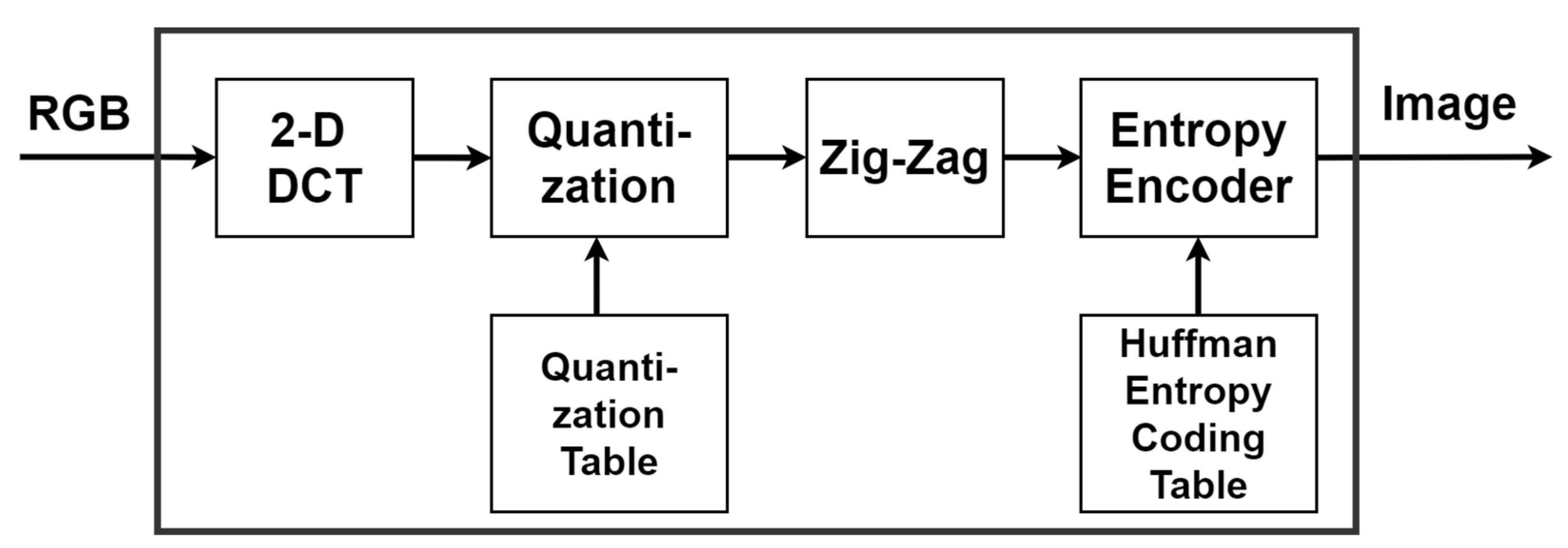



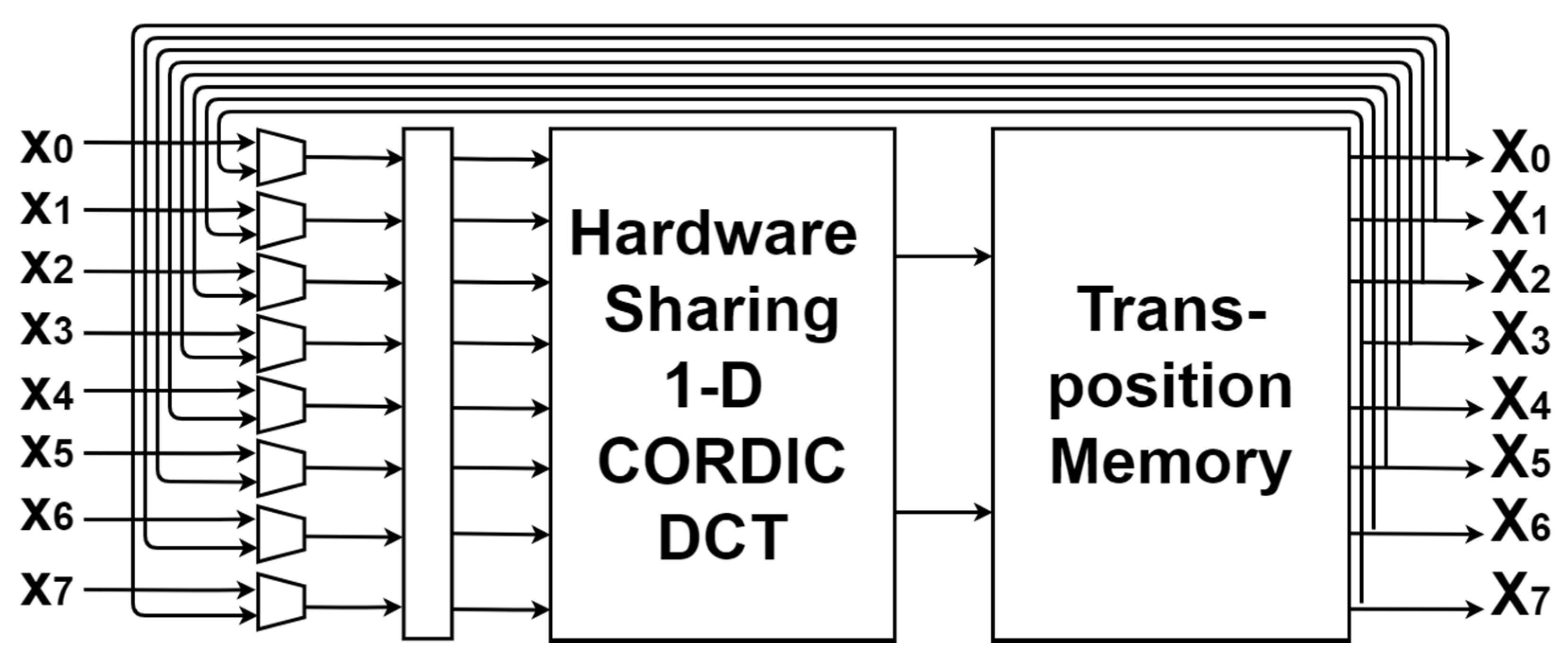

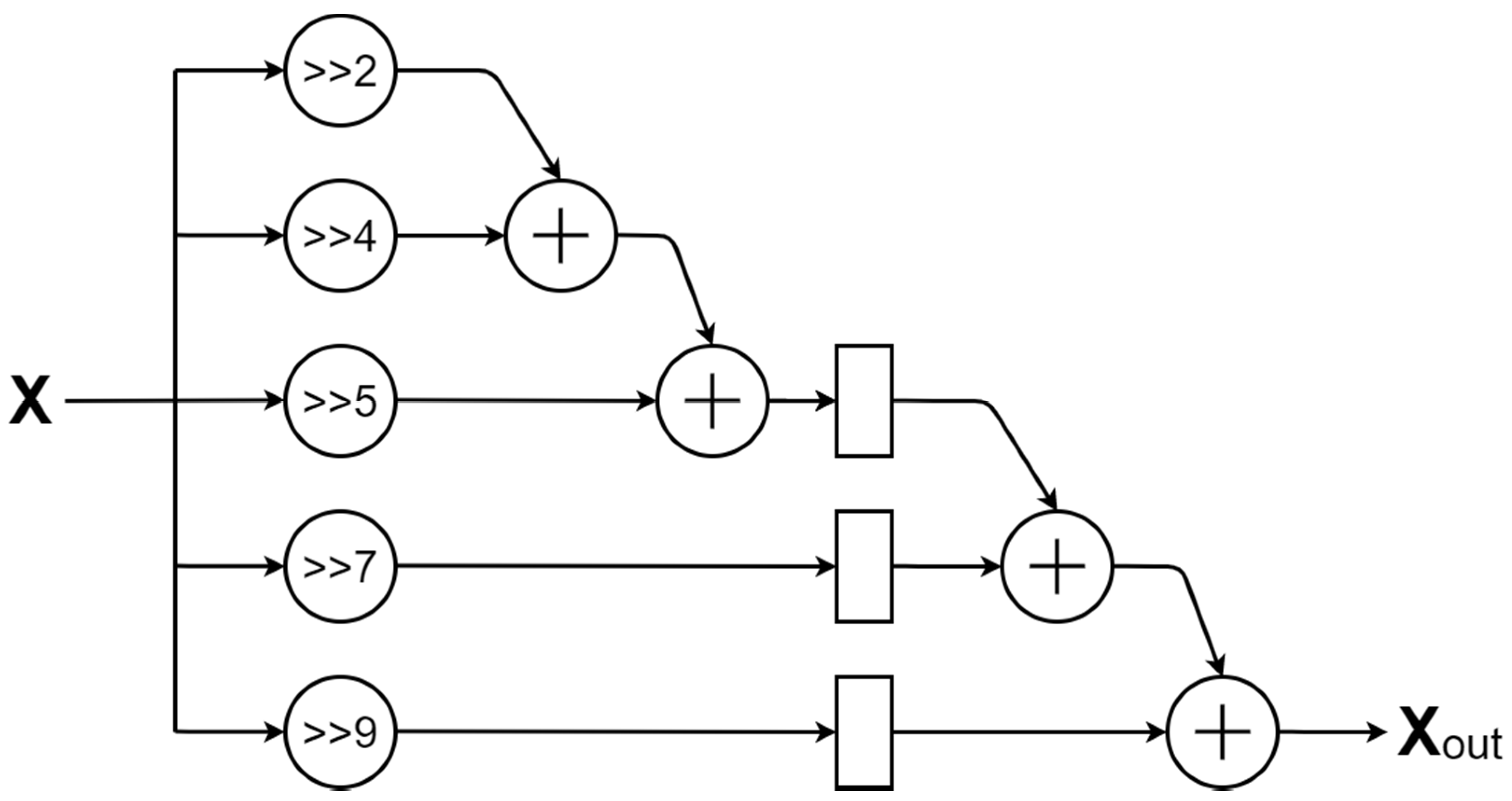
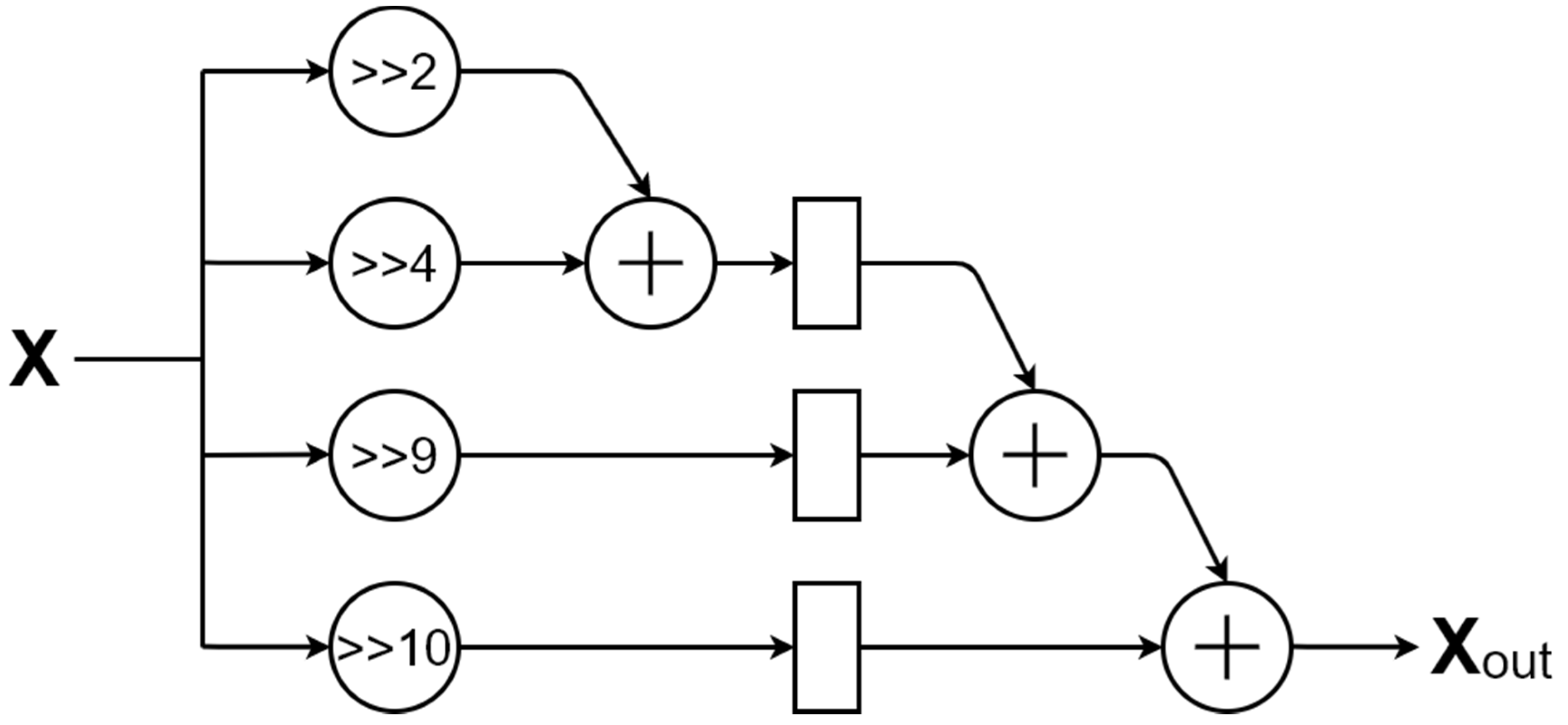

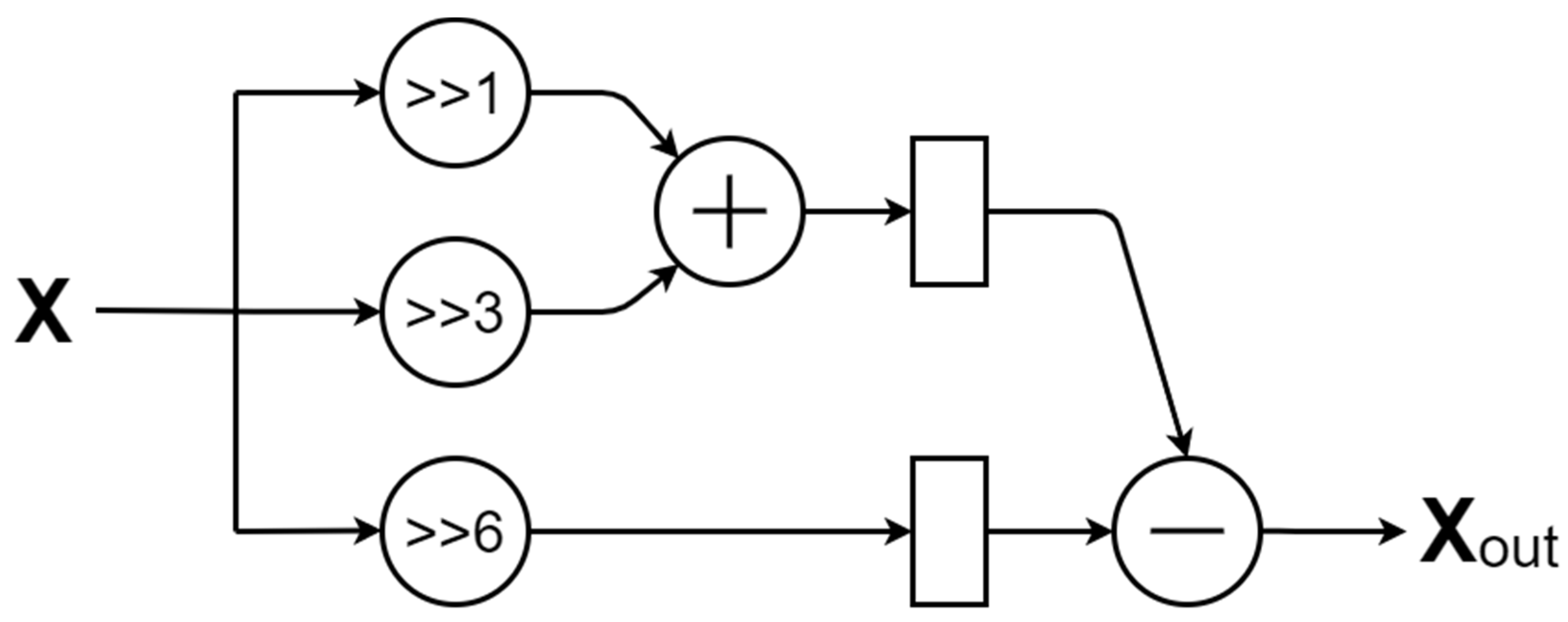


| Scale Factor | Quantization Value | Quantization Erorr | Add | Shift |
|---|---|---|---|---|
| 0 | 0 | 1 | ||
| 4 | 5 | |||
| 3 | 4 |
| Iteration (i) | Angle = 3π/8 | Angle = 3π/16 | Angle = π/16 |
|---|---|---|---|
| 0 | σ = 1 | σ = 1 | σ = 1 |
| 1 | σ = 1 | σ = −1 | σ = −1 |
| 2 | σ = −1 | σ = 1 | σ = −1 |
| 3 | σ = 1 | σ = 1 | σ = 1 |
| 4 | σ = 1 | σ = −1 | σ = −1 |
| 5 | σ = −1 | σ = −1 | σ = 1 |
| 6 | σ = 1 | σ = −1 | σ = 1 |
| 7 | σ = 1 | σ = 1 | σ = 1 |
| 8 | σ = −1 | σ = −1 | σ = 1 |
| 9 | σ = −1 | σ = 1 | σ = −1 |
| 10 | σ = 1 | σ = 1 | σ = 1 |
| Loeffler [28] | Sun [29] | Lee [30] | This Work | |
|---|---|---|---|---|
| Airplane | 35.85 | 34.83 | 35.48 | 35.84 |
| Splash | 37.72 | 37.02 | 37.42 | 37.70 |
| Lena | 34.51 | 33.96 | 34.37 | 34.50 |
| Mandrill | 27.61 | 27.13 | 27.40 | 27.60 |
| Girl | 34.68 | 34.29 | 34.48 | 34.67 |
| House | 33.74 | 32.76 | 33.31 | 33.72 |
| Peppers | 33.25 | 32.82 | 33.07 | 33.24 |
| Sailboat | 31.04 | 30.49 | 30.85 | 31.04 |
| Average | 33.55 | 32.91 | 33.30 | 33.54 |
| Loeffler [28] | Sun [29] | Lee [30] | This Work | |
|---|---|---|---|---|
| Kodak01 | 28.57 | 27.99 | 28.33 | 28.56 |
| Kodak02 | 32.93 | 32.58 | 32.81 | 32.92 |
| Kodak03 | 34.33 | 33.86 | 34.17 | 34.32 |
| Kodak04 | 33.10 | 32.55 | 32.96 | 33.09 |
| Kodak05 | 28.87 | 27.91 | 28.57 | 28.86 |
| Kodak06 | 30.02 | 29.49 | 29.81 | 30.00 |
| Kodak07 | 33.94 | 32.93 | 33.71 | 33.93 |
| Kodak08 | 28.35 | 27.37 | 27.86 | 28.34 |
| Kodak09 | 33.84 | 33.01 | 33.59 | 33.83 |
| Kodak10 | 33.62 | 32.86 | 33.36 | 33.61 |
| Kodak11 | 30.81 | 30.27 | 30.61 | 30.80 |
| Kodak12 | 33.96 | 33.32 | 33.71 | 33.94 |
| Kodak13 | 26.25 | 25.67 | 26.02 | 26.24 |
| Kodak14 | 30.12 | 29.51 | 29.94 | 30.19 |
| Kodak15 | 32.88 | 32.33 | 32.62 | 32.87 |
| Kodak16 | 32.32 | 31.99 | 32.19 | 32.31 |
| Kodak17 | 32.73 | 32.13 | 32.52 | 32.72 |
| Kodak18 | 29.52 | 28.93 | 29.32 | 29.51 |
| Kodak19 | 31.35 | 30.59 | 31.02 | 31.34 |
| Kodak20 | 32.72 | 32.03 | 32.42 | 32.71 |
| Kodak21 | 30.40 | 29.78 | 30.16 | 30.40 |
| Kodak22 | 31.39 | 30.92 | 31.23 | 31.38 |
| Kodak23 | 35.84 | 34.95 | 35.57 | 35.82 |
| Kodak24 | 29.27 | 28.61 | 29.00 | 29.26 |
| Average | 31.55 | 30.90 | 31.31 | 31.54 |
| DCT Type | Multiply | Add | Shift |
|---|---|---|---|
| Loeffler DCT [28] | 22 | 58 | 8 |
| Sun [29] | 0 | 120 | 92 |
| Lee [30] | 0 | 192 | 172 |
| This work without hardware sharing machine | 0 | 108 | 96 |
| This work with hardware sharing machine | 0 | 28 | 11 |
| Original | Loeffler [28] | Sun [29] | Lee [30] | |
|---|---|---|---|---|
| Lena |  |  |  |  |
| PSNR | 34.51 dB | 33.96 dB | 34.37 dB | |
| Kodak03 |  |  |  |  |
| PSNR | 34.33 dB | 33.96 dB | 34.37 dB |
| Performance Metric | Sun et al. [29] | Lee et al. [30] | Kim et al. [36] | Wu et al. [37] | This Study |
|---|---|---|---|---|---|
| PSNR (dB) | 30.90 | 31.31 | 31.49 | 31.55 | 31.54 |
| Compression Ratio | 9.86 | 9.86 | 9.86 | 9.86 | 9.86 |
| Process (µm) | TSMC 0.13 | TSMC 0.13 | TSMC 0.13 | TSMC 0.13 | UMC 0.18 |
| Operating Frequency (MHz) | 100 | 100 | 100 | 100 | 100 |
| Gate Count (k) | 27.30 | 22.40 | 24.60 | 31.50 | 8.04 |
| Power (mW) | 6.54 | 5.11 | 5.42 | 5.62 | 4.17 |
| Core Area (µm2) | 255 k | 209.2 k | 229.8 k | 294.2 k | 75.1 k |
| Memory | 96 | 96 | 96 | 96 | 96 |
| Normalized Gate Count | 3.40 | 2.79 | 3.06 | 3.92 | 1.00 |
| FOM | 11.16 | 13.78 | 12.62 | 9.88 | 38.68 |
Publisher’s Note: MDPI stays neutral with regard to jurisdictional claims in published maps and institutional affiliations. |
© 2021 by the authors. Licensee MDPI, Basel, Switzerland. This article is an open access article distributed under the terms and conditions of the Creative Commons Attribution (CC BY) license (https://creativecommons.org/licenses/by/4.0/).
Share and Cite
Chung, R.-L.; Chen, C.-W.; Chen, C.-A.; Abu, P.A.R.; Chen, S.-L. VLSI Implementation of a Cost-Efficient Loeffler DCT Algorithm with Recursive CORDIC for DCT-Based Encoder. Electronics 2021, 10, 862. https://doi.org/10.3390/electronics10070862
Chung R-L, Chen C-W, Chen C-A, Abu PAR, Chen S-L. VLSI Implementation of a Cost-Efficient Loeffler DCT Algorithm with Recursive CORDIC for DCT-Based Encoder. Electronics. 2021; 10(7):862. https://doi.org/10.3390/electronics10070862
Chicago/Turabian StyleChung, Rih-Lung, Chen-Wei Chen, Chiung-An Chen, Patricia Angela R. Abu, and Shih-Lun Chen. 2021. "VLSI Implementation of a Cost-Efficient Loeffler DCT Algorithm with Recursive CORDIC for DCT-Based Encoder" Electronics 10, no. 7: 862. https://doi.org/10.3390/electronics10070862
APA StyleChung, R.-L., Chen, C.-W., Chen, C.-A., Abu, P. A. R., & Chen, S.-L. (2021). VLSI Implementation of a Cost-Efficient Loeffler DCT Algorithm with Recursive CORDIC for DCT-Based Encoder. Electronics, 10(7), 862. https://doi.org/10.3390/electronics10070862







